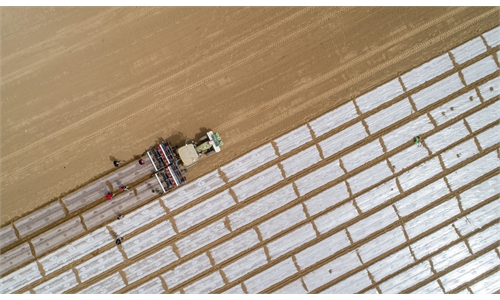China to improve redistribution mechanisms to narrow income gap: top economic planner

Aerial photo taken on May 2, 2021 shows visitors at Shenxianju scenic area in Taizhou, east China's Zhejiang Province.(Photo: Xinhua)
During the 14th Five-Year Plan period (2021-25), China will improve the redistribution mechanisms and made more forceful and targeted adjustments to taxation, social security and other methods to narrow income gap, the country's top economic planner said on Tuesday.
Development remains the first priority to further control and narrow the gap between the rich and the poor. China will improve the mechanism of reasonable wage growth and has vowed to increase incomes among low-income groups and expand the middle class, Ning Jizhe, head of the National Development and Reform Commission (NDRC), said on Tuesday during a press conference for the release of a white paper titled "China's Epic Journey from Poverty to Prosperity."
With a population of over 1.4 billion, China has an expanding middle class of over 400 million people, offering a supersized market growing faster than any other country on Earth, according to the white paper.
The white paper documents the country's journey to moderate prosperity in all respects, or xiaokang. China has declared the realization of xiaokang in July, which marks a critical step toward national rejuvenation.
"The process of completing the implementation of xiaokang in China is a process in which poverty is being reduced and people are getting richer. China's economic strength has continued to rise, people's living standards have improved in an all-round way, and the pattern of individual income distribution has gradually improved," said Ning.
Ning noted that although there is still a gap between the rich and the poor, the income gap between urban and rural areas, between different regions and among different groups is generally narrowing.
The per capita disposable income ratio of urban and rural residents decreased year by year, from 2.99 in 2010 to 2.56 in 2020, per the white paper.
"Taxation already played an important role in income distribution in China. The country will uphold a distribution system whereby distribution according to labor is dominant and a variety of other modes of distribution coexist, and improve its distribution system through the development of economy, expanding employment, and increasing household income," said Ning.
Personal income depends not only on disposable household income, but also on the public services provided by the government to improve livelihoods. In the process of building a moderately prosperous society, all regions and departments have actively promoted equal access to basic public services, the white paper says.
Significant progress has been made in improving the multi-tiered social security system. China has built the world's largest social security net, with more than 1.35 billion people covered by basic medical insurance and 1 billion people covered by seniors' insurance.
The equity and quality of education continued to improve, with the completion rate of nine-year compulsory education reaching 95.2 percent in 2020.
According to the white paper, China has sustained healthy economic growth on the path to realizing xiaokang.
With per capita GDP rising from less than $100 in 1952 to over $10,000 in 2020, China has achieved a historic transformation from a low-income country to an upper-middle-income country.
The average per capita disposable income has risen from 171 yuan ($26) in 1978 to 32,189 yuan ($4,971) in 2020, per the white paper.
Global Times



